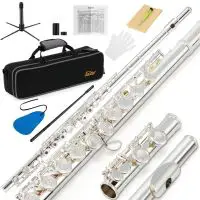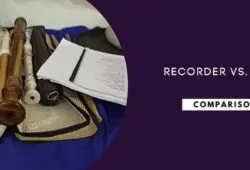The market is flooded with different makes and models, and nearly every salesperson I talked to came across as pushy rather than addressing my particular concerns.
And don’t even get me started on the second-hand flutes whose prices always appeared too good to be true.
Well, many years down the road and several decent flutes later, I’d consider myself to be pretty conversant with the nitty-gritty of buying a flute.
Knowing how much of a hustle it can be, I’m always glad to share some tips with budding flutists.
How about I help you find the best intermediate flute your money can buy. Sounds good?
Table of Contents
Best Flutes for Intermediate Players Reviewed
This flute is made from genuine Cupronickel, which – as you may have already figured – is an alloy of copper and nickel.
This material is chosen for its high durability, and the Cupronickel metal is then coated with silver.
This improves the flute’s appearance and contribute towards the sweet tone produced.
Tuned to the key of C, this Glory flute comes with a C footjoint and an open hole design.
These step-up features are bound to offer a good challenge for the budding flutist.
At the same time, however, silicone plugs have been provided and allow for the instrument to be played either open or with closed holes.
One impressive feature is the split E mechanism, which is not something you’d typically find on a budget instrument such as this one.
There are 16 keys on this Glory flute. These are covered with high-quality leather pads that offer great water resistance and airtightness.
Just as well, the high-grade needle spring used in this flute guarantees that you will be using it for an extremely long time without experiencing any issues.
The instrument comes with a tuning rod, polish cloth, joint grease, a pair of white gloves, a screwdriver, and a pretty decent case.
Any intermediate player would be impressed with this flute, it has a great tone, allows you to play higher octaves with ease, and is a budget-friendly option.
- Inexpensive.
- Made from high-quality materials.
- Has a split E mechanism.
- Decent tone quality.
- Includes a ton of accessories.
- Assembling the flute requires a good amount of lubrication.
Jupiter is known for making superior quality flutes that are durable, reliable, and offer good value for money.
This particular flute comes with a .925 solid sterling silver headjoint, which is just what you want in an upper-level flute.
The high silver content produces a darker, richer tone with impressive warmth, power, and projection.
To keep the price fairly affordable, the body, keys, and footjoint are made from silver-plated nickel, which is still a very durable metal.
No products found.
Intermediate flutes should offer a good challenge for the player, and the open holes on this flute guarantee just that.
Besides allowing players to perfect their fingering techniques, the open hole design also allows for a quicker response and more clarity.
At the same time, this Jupiter flute comes with an offset G key, and this ergonomic design allows for more comfortable playing.
Also, there is a gizmo key (High C Facilitator Key) included, and this improves intonation on High C, making it easier to play.
Tuned to the key of C, this instrument comes with a B footjoint, which extends the range of the flute to low B. The B foot also darkens the tonal color of the flute.
This intermediate flute comes with a neat French case and cover.
- Extremely high-quality instrument.
- Solid sterling silver headjoint.
- Offset G key and Gizmo key for ease of playing.
- Beautiful, full, rich tone.
- Comes with hole plugs.
- Doesn’t have a split E mechanism.
Another renowned company, Gemeinhardt, is a German flute company with a reputation for making well-made flutes that have a nice tone and are physically nice to play.
The model 3OB is a silver-plated flute featuring Gemeinhardt’s exclusive 4-post footjoint construction.
This is done to make the flute, especially strong and sturdy.
Another unique feature of this flute is the unique embouchure hole design, proportioned tone holes, and pad caps.
The minute you pick up this instrument, you will understand why the brand is known for making instruments that are physically very comfortable to play.
The proportioned tone holes and pad cups ensure an even response throughout all registers, and this comes with an extraordinary tone as well.
Additionally, the flute comes with a Gizmo Key (High C Facilitator Key), which is pretty much standard on all B-foot flutes.
The open hole French Style keys have drawn holes, so you don’t have to worry about flimsy soldering coming apart after years of use.
Also, the flute features superior key mechanisms that allow for fast action and outstanding playability.
This high-end intermediate flute comes with a cleaning rod and a case.
- Remarkably responsive.
- Outstanding playability.
- Great mechanical accuracy.
- Amazing sound quality.
- 5-year manufacturer’s warranty.
- Not made from solid silver.
The Yamaha YFL-222 comes with a nickel silver body, headjoint, and footjoint, complete with a silver-plated finish.
Tuned to the key of C, the flute comes with a C footjoint.
The footjoint has a unique alignment marking that facilitates proper fitting by younger players.
The tone holes on this instrument are drawn and curled, and the keys have neoprene bumpers that are stronger and more durable than cork.
Keep in mind that this intermediate flute has closed-hole keys to facilitate ease of playing. Just as well, the G key is offset for the same reason.
This flute guarantees even, quick response in all registers, which is something advanced flutists are bound to appreciate.
The CY headjoint of this flute comes with a unique embouchure hole undercut design, allowing for excellent response and a warm, rich tone.
This unique embouchure design makes the flute comfortable to play, which can also be credited to the ergonomically designed key shapes and placement.
Along with the flute, the player gets a polishing cloth, cleaning rod, polishing gauze, and a plastic flute case.
- Reasonably priced.
- Extremely durable.
- Plays easy.
- Effortlessly responds to articulation.
- European-style pointed key arms design.
- The D# trill key is a bit too close to the D key.
Any person who plays music instruments knows that Mendini by Cecilio is the go-to brand if you’re looking for a quality, value instrument that’s affordably priced.
This intermediate flute truly lives up to that claim.
To begin with, the body is made from premium-grade nickel plating while the keys contrast this look with beautiful gold color.
The flawless finish on this flute is quite attractive, but besides simply looking good, the instrument plays just as impressively.
To ease with playability, the headjoint has an undercut beveled embouchure. Additionally, the G key is offset, and the instrument also comes with a split E mechanism.
Tuned to the key of C, this Mendini flute has 16 keys and a closed-hole key design.
The double bladder pads on the keys are high quality and very durable, and there are also rubber key bumpers in this flute.
For easy use and maintenance of the instrument, this flute comes with a cleaning rod, cleaning cloth, a pair of white gloves, joint grease, and a case.
Additionally, you have a flute pocketbook and a foldable flute stand, which provides a flexible playing experience.
- A pretty decent flute for the price.
- Comes with a foldable flute stand.
- Double bladder pads create a nice airtight seal.
- Easy-to-use lip plate design.
- 1-Year warranty.
- Lacks the rich tone of a solid silver flute.
Is there any flutist alive who isn’t familiar with Pearl? This reputable brand guarantees flutes that will hold their value even after years of frequent use.
The Quantz 505 series is a novice model line of Pearl’s most economical flutes, but don’t be fooled.
These ‘budget’ flutes perform just as impressively as their costlier counterparts.
To begin with, this open hole flute features French pointed arms which is just what you’d get on a high-end pearl flute.
No products found.
French pointed arms have always been a feature commonly associated with semi-professional and professional-grade flutes.
This B footjoint flute is fully silver-plated and comes in a one-piece, core-bar construction for better durability, guaranteeing that the flute stays in adjustment longer.
Another superior feature is the pinless mechanism, which allows for easier servicing of the instrument and renders the flute less prone to rusting.
All these features mean that although this is a novice line instrument, it still upholds the trademark Pearl sound and intonation standards that the brand has come to be associated with.
Along with the flute, a French-style case and cover have been provided.
- Inexpensive.
- Solidly built using top-grade materials.
- Has a split E mechanism.
- Durable pinless construction.
- Fluid, dependable mechanism.
- With time, you might need to upgrade to a solid silver headjoint.
The minute you start playing this flute, you will understand why it is among the most sought-after step-up flutes in the market.
This 3SHB model flute from Gemeinhardt comes with a solid silver headjoint, which is just what you want in a step-up instrument.
The J1 headjoint has a standard wall thickness, and this offers the least resistance so that you get a warm, round tone.
With this B-foot flute, you get an extremely quick response in the low register.
Just as well, the high register remains pleasantly free-blowing.
The French open hole key design is bound to open up many repertoire options for the flutist in the future, thereby enriching their skills and techniques.
Should you happen to prefer a closed-hole key design, then that’s not a problem either.
Just plug in the provided keycaps, and you can play the flute closed, gradually opening up some holes as you go.
The flute comes with a silver-plated body and features Gemeinhardt’s exclusive 4-post footjoint construction for extra strength and durability.
This high-end intermediate flute comes complete with a cleaning rod, a hard-shell case, and a case cover.
- Smooth key action.
- Very clear sound and mellow tone.
- Extremely easy to hit the upper and lower registers.
- Easy to maintain.
- 5-year manufacturer’s warranty.
- The inline G key might not favor players with short fingers.
What Is the Difference Between Beginner and Intermediate Flutes?
Let’s start here: all flutes are essentially the same.
That being said, regardless, don’t go buying an intermediate or advanced flute until you are sure that your playing is at that level.
It will take about 5 years since you first started playing, for you to upgrade from a beginner flute to an intermediate flute.
Don’t be too quick to jump the gun.
If a flutist doesn’t possess the skills to play at a higher level, then the instrument won’t matter. There would be virtually no sound difference, even if the player were to be given a professional flute to play on.
Beginner Flutes
Beginner flutes are made such that it’s easy for the player to produce sound from the instrument. Such flutes are lightweight, easy to play, and are built to withstand knocks and bumps.
These flutes have a very simple design with minimal add-ons and basic specs that are pretty standard across different brands.
Beginner flutes are also almost always factory-made, and for these reasons, they have a pretty low price point.
Also contributing towards the affordability of beginner models is the fact that these flutes are made from silver-plated nickel.
So, you get the beautiful sound of a full silver flute but without the additional cost.
Beginner flutes always have a C footjoint, so the lowest note that can be played on these flutes is a C.
The hole keys are always closed, so the beginner player isn’t required to use intricate and complicated hand positioning to play tunes.
Intermediate Flutes
Intermediate flutes are designed to offer more professional specs than a beginner flute but still staying budget-friendly for the budding flutist.
Heavier than their beginner counterparts, step-up flutes are meant to be used by players who can already play the flute to an extent.
Their design isn’t meant to be easy to play, but instead, the instrument offers a much fuller sound with better projection than what one would get with a beginner flute.
A handmade headjoint is one of the professional specs included, and this contributes towards the higher mark-up.
These models also often come with open-hole keys as opposed to the closed holes found on beginner models.
With open holes, the player has a bigger challenge when it comes to hand placement, meaning they have to master perfect hand positioning.
However, this feature is also advantageous because it allows for a clearer sound to be produced from the instrument.
Open holes also allow players to learn certain extended techniques, such as the quarter tones, for instance.
Intermediate flutes often come with a B footjoint, meaning you have another key that allows you to play a low B. The result is a richer sound, which is just what you want when advancing as a flutist.
Lastly, these flutes tend to have a higher silver content in comparison to beginner models. The more silver, the better quality the flute is.
With intermediate models, you’ll have a solid silver body, headjoint, and footjoint, which results in better sound quality.
Student flutes come as is, but it is at the intermediate level whereby a player can start customizing their flute.
Intermediate flutes offer extra features that could help achieve certain notes and fast passages. Common customization options include the split E, the G disc, or the C# trill key.
How to Choose the Best Intermediate Flute for You
Silver Content
Now, here’s the first thing you should know: if a flute doesn’t contain any real silver on it, then it isn’t an intermediate or professional level flute.
The idea isn’t to go for a silver-plated instrument; it is to have the instrument made from solid silver.
Having the entire flute (headjoint, body, and footjoint) made from solid silver could end up being pretty pricey, though. So, at the very least, ensure the headjoint is solid silver.
The most basic intermediate flute will have a silver head because this component has the most significant impact on resonance, tone, and responsiveness of the flute. The sound produced is notably clearer.
A genuine solid silver headjoint will have the “Sterling”, “Silver”, or “925” stamped near the crown.
“925” indicates sterling silver with a 92.5% silver purity, and this is the most widely used type of silver when it comes to manufacturing flutes.
When it comes to the flute body, pay attention to its density, thickness, and finish as all these will alter the responsiveness and tone of the instrument.
The trained ear will notice an acute difference in the tone’s depth when distinguishing between a silver-plated body and a solid silver body.
However, both instruments can still be played masterfully as long as the headjoint is composed of solid silver.
The advantage of a solid silver body is that it will tarnish less and are also less likely to corrode owing to the pH of oils on our bodies.
If you can afford it, an all-silver intermediate flute would be a perfect investment. If you have a tight budget, you could compromise on the body and footjoint but never on the headjoint.
Always get a silver headjoint, at the very least.
G Key: Offset Vs. Inline
An offset G key is very ergonomic and allows the player to reach the key using their ring finger easily.
For this reason, many student flutes come with an offset G key, but this feature isn’t reserved purely for beginner flutes.
The ergonomic properties of an offset G key would be desirable on an intermediate flute as well.
However, this offset design would require the key to have its own set of ribs, posts, and key rods, and this could add a bit of weight to the instrument.
An inline G key is presumably easier to manufacture, seeing as the key can be integrated right within the mechanism of the other tone hole keys.
Being less ergonomic, however, this design might lead to performance-related injuries, such as carpel-tunnel-syndrome.
The choice between an inline versus an offset G key on the flute has been an ongoing debate amongst professional flutists and amateurs alike.
There appears to be a stigma that using an offset G on an intermediate or professional flute makes one less of a professional.
Ultimately, the choice between the two will be based solely on what the player prefers and what they find more comfortable to use.
There is really no price difference between the two, and neither is there any difference in the sound output.
Closed Hole Keys Vs. Open Hole Keys
An open hole top is also referred to as ‘French Style’ whereas a closed-hole flute is also known as ‘Plateau’.
When it comes to closed-hole flutes, there are no holes in the middle of the keys required to be covered by the player’s fingers.
This is a popular feature on beginner flutes, and it allows a flutist to focus on other aspects of the instrument, rather than get caught up in proper hand placement.
As you advance to an intermediate flute, however, it is common to find these higher-level instruments having open holes. And these open holes are essentially small holes on 5 keys of the flute.
Their advantage is that they provide an opportunity to practice more advanced playing techniques, and give a slightly enhanced resonance.
Intermediate flutes may come with either open holes or closed holes. If a player finds that the open holes are a problem for them, then there is the option of temporarily getting plugs to seal the holes.
The advantage of using these plugs is that the player can remove them one at a time as they build their confidence using an open hole key flute.
I would suggest you get an open hole intermediate flute because it would open up a lot of repertoire options for the budding flutist, even in the future.
Drawn Holes Vs. Soldered Holes
Drawn tone holes are mechanically drawn from the tube of the flute’s body.
Soldered tone holes involve first making holes in the tube of the flute’s body, then attaching pre-made key “chimneys” by soldering them onto the created holes.
This complex process must be done with extreme precision, so it can be quite a costly method.
Regarding sound output, some flutists seem to believe that soldering results in more responsiveness, and thereby, a more interesting sound is produced.
Once again, this comes down to a matter of personal preferences. The price difference between these two types of flutes could be quite substantial.
So, make sure you are convinced of the differences in sound quality before you invest in one flute over the other.
C-Footjoint Vs B-Footjoint
Beginner flutes typically have a C footjoint meaning the lowest note that can be played on such an instrument is C. C footjoints tend to have a clearer upper register.
Intermediate flutes will have a B footjoint, and this allows the instrument to play a low B, thereby producing a richer sound.
A B footjoint darkens and enriches the flute’s sound, whereas a C footjoint lends a lightness to the instrument (both in terms of weight and sound).
Split E Mechanism
There are bound to be a few problematic notes while playing the flute. These notes include the Middle E, High E, C#, and High F.
To help you play a High E with more ease, the intermediate flute may come with a mechanism that makes this note easier to play, all without affecting any other notes on the flute.
A Split E mechanism modifies the G key, thereby splitting the two keys that are pressed to play G.
This modification means that the lower of the two G keys will close when High E is played, thereby making it much easier to play the note.
FAQs About The Best Flutes for Intermediate Players
How Much Is an Intermediate Flute?
To purchase an intermediate flute, expect to spend anywhere between $700 and $2,500.
The overall cost of a flute will be influenced by:
- Metal used for the headjoint, body, and footjoint (nickel silver, solid sterling silver, gold, platinum, etc.).
- The brand.
- Condition of the flute/manufacturing process.
- Additional features (low B foot, E mechanism, C# trill key, etc.).
- The quality of the case that’s included with the flute.
- After-sales services.
Do Open Hole Flutes Sound Better?
Proponents of the open hole flute seem to agree that this design allows for a freed sound that sounds richer.
I often find the resonance of an open hole flute to be slightly more enhanced than what you’d get from a closed-hole flute.
Also, I like that with an open hole flute, I can feel the vibration in my fingertips; therefore, feeling more connected to my sound.
This is often a hotly debated issue though, so I’d say, play both instruments then decide for yourself which one you seem to like more.
What Does C Flute Mean?
A C flute comes with a C footjoint meaning the lowest note a flutist can play on this instrument is C.
What Is the Difference Between B and C Flute?
A B flute is a couple of centimeters longer than a C flute, and it is also slightly heavier than the latter.
While C flutes have the advantage of a clearer upper register, B flutes have the advantage of producing a richer sound.
Conclusion
A good intermediate flute will sound much better than the flute you were using previously, and will also be very comfortable to play.
The durability of a great intermediate instrument is extremely impressive.
You will need to spend very little on maintenance, and depending on the brand in question, a good instrument should hold its value even decades down the line.
Unless you intend to go pro, a good intermediate flute should last you the rest of your life.
So, as you see, buying this instrument is not a decision that should be made hurriedly. Take your time playing different brands and models until you find a sound you truly fall in love with.










